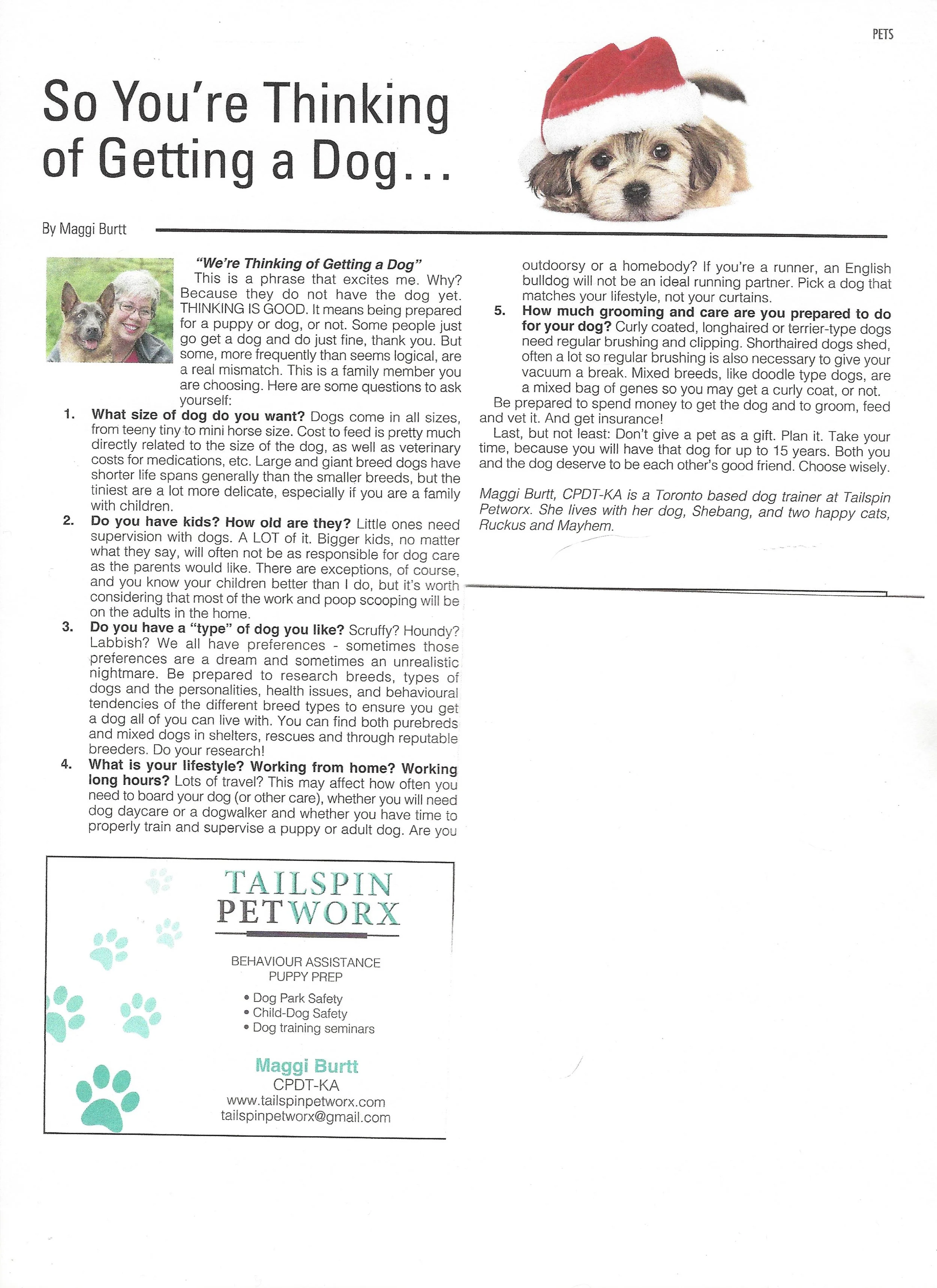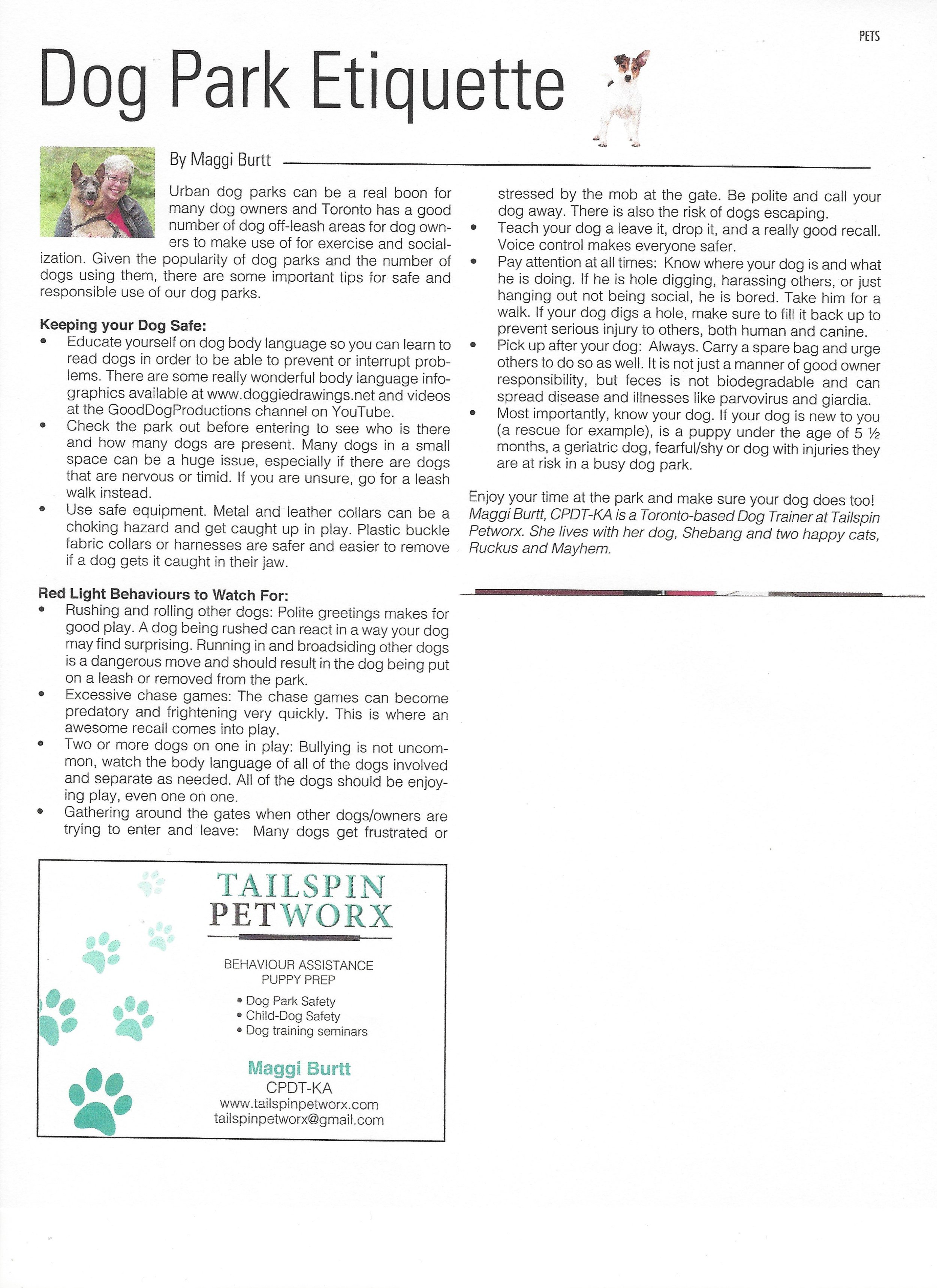Urban dog parks can be a real boon for many dog owners and Toronto has a number of dog off- leash areas to make use of for exercise and socialization. City of Toronto OLAs
There are considerations to keep in mind though as they are not always the utopia we envision for our pups. There are not enough of them, they are often not large enough and are not always the ideal place for YOUR dog, but given the popularity of dog parks and the number of dogs using them, here are some important tips for safe and responsible use.
PICK THE RIGHT PARK
Just because it’s the closest doesn’t make it the right one for your dog. Some dogs need a park with a small dog area, or wide open spaces, or fences or trails….take a look at the different off leash areas available to you and think about which ones may be the best solution for you and your dog. Does it have parking? Water nearby? Is it accessible if you need accommodations? What is the substrate? Is it adequately fenced for YOUR dog and their possible escape abilities?
KEEPING YOUR DOG SAFE
Educate yourself on dog body language so you can learn to read, prevent and interrupt when needed. There some great videos here:
Understanding Dog Body Language-Kristin Crestejo
Understanding Dog Body Language Part TWO- Kristin Crestejo
This channel has lots of videos of dog park ISSUES between dogs and is a very educational to watch.
Great Dog Productions: Dog Parks
One of the best BOOKS on dog body language, with amazing illustrations
Doggie Language by Lili Chin
Check the park out before entering to see who is there and how many dogs are present. Watch the owners as well. Are they paying attention and interacting with their dogs? On their phones and disconnected? Are there too many dogs? What are they all doing? Many dogs in a small space can be a huge issue, especially if there are dogs that are nervous or timid. If you are unsure, go for a leash walk instead. My local park is great, except for a dog that does NOT like mine, so if this dog and her owner are there, we go elsewhere.
Use safe equipment Metal or leather collars can be a choking hazard and can get caught up in play. Plastic buckle fabric collars or harnesses are safer and easier to remove if a dog gets it caught in their jaw. Naked is best for at home with dog friends visiting, but since they have to wear SOMETHING to the park please make sure that it is safe for rough play.
Toys can be problematic. It is best to not bring toys or limit toy play to very low traffic times with dogs YOU KNOW. Toys are pretty common at dog beaches, so if you bring one, don’t expect that it won’t get stolen at least once and yes, you may not get it back. I always bring TWO toys to the beach so there is no issue of resource guarding and if one “leaves with a friend” even temporarily, it’s not a huge loss.
RED LIGHT BEHAVIOURS
Rushing or Rolling other dogs. Polite greetings make for good play. A dog being rushed can react in a way you and your dog may regret. Rolling other dogs from across the park is pretty aggressive and not PLAY. If your dog does this they should be leashed and removed. They can seriously injure another dog or person.
Excessive chase games. The chase games can become frightening or predatory very quickly. Big dogs chasing small ones is a serious incident risk. Please do not allow chasing that involves more than one or two dogs that are not over-aroused or vastly different in size. This is really where your recall training and leave it training are safety skills. Call them out BEFORE it gets intense or do not allow it at all. My last dog would drift into her predatory chase quite easily so I greatly limited her chasing time to actual squirrels and not other dogs.
Two or more dogs on one Bullying is not uncommon, watch the body language of all the dogs involved and separate as needed. All of the dogs should be be enjoying play and it should be consensual, not forced.
Excessive humping or obsessive bothering of a specific dog. You need to remove your dog.
Gathering around the gates when other dogs/owners are trying to enter and leave. Many dogs get frustrated or stressed by the mob at the gate. Be polite and and call your dog away or go and get them. Every time. If it’s you trying to enter, WAIT until the crowd leaves or ask people to come get their dogs.
THE HUMAN PART OF THE EQUATION
Teach your dog Leave it, Drop it and a really good recall. Voice control makes everyone safer. You will need to proof it adequately so it will happen when you need it. Consult a trainer.
Pay attention at all times. Know where your dog is and what he is doing. If he is hole digging, harassing others, or just hanging out not being social especially if he’s hanging around near the entrance of the park, he needs to go for a walk or go home. Seriously, if you need to make that phonecall or play that game on your phone, you should not be walking your dog at the same time. Talking with others at the park is part of what some people like about it…but it CAN be possible to both chat and watch. Your dog is your priority.
Fill in holes, even if they are not from YOUR dog to prevent serious injury to others, both human and canine. Yes, SERIOUS injuries. I’ve seen broken legs, ankles and wrecked knees on both dogs and humans because of holes. Don’t assume it’s okay to let your dog dig and not fill it in.
Pick up after your dog. ALWAYS. Carry spare bags and urge other to do so as well. It is not simply a matter of good owner responsibility, but feces can spread disease like parvo and parasites like giardia. Also, just FYI, bagging it and then leaving it on the trail, in a tree or on a bench does NOT count. I mean it.
If your dog BITES or INJURES ANYONE (dog or human) you are responsible. End of story. There can be many reasons a dog may bite but that is not as important as ensuring the dog and human get your name and contact information. Dog parks are absolutely a “use at your own risk” environment but that does not remove YOUR responsibility if your dog injures someone else. A little nick on the ear or muzzle from an overcorrection is not a huge deal, but anything else really is. Dog Owners' Liability Act- Ontario
If your dog is BITTEN or INJURED by another dog, then that owner needs to also be responsible. The best way to ensure this is to have an onlooker ask them to TEXT or Call immediately to your phone or theirs so you have an actual, real phone number. If you are a WITNESS to something like this, be that person who helps.
Pet First Aid is THING that all dog owner’s should know. Get certified. There are several good Pet First Aid classes you can take, both in person and online.
Most importantly, know your dog. If your dog is new to you (a rescue for example), is a puppy under the age of 5.5 months, a geriatric dog, an intact male dog, fearful/shy or has injuries they are at risk in a busy dog park. If they are very reactive, have aggression or severe fear issues then a dog park is NOT FOR YOU. Parks are for ALREADY socialized and social dogs to play.
If you need private spaces Sniffspot can be very valuable, as you can rent spaces to run your dog privately or with a friend or two. Some daycares and boarding facilities in the GTA also offer rental spaces for runs. Ask around, I have gone to K925 Elite Dog Kare in Queensville a few times and Shebang loved it!







